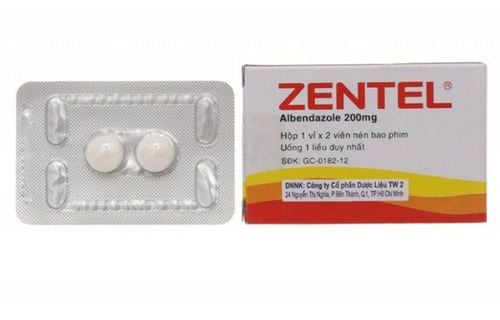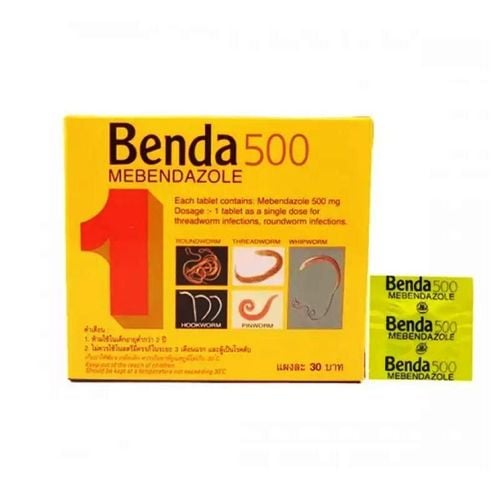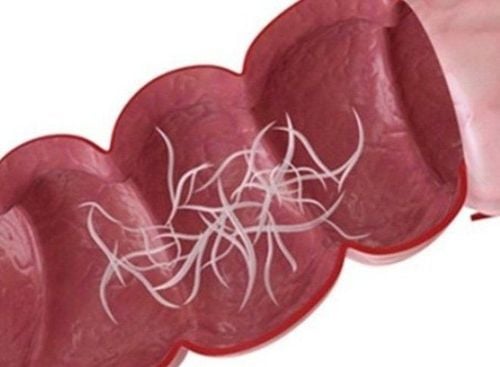This is an automatically translated article.
Pilavos is known to be a drug capable of treating worm larvae moving into the visceral organs, especially roundworm larvae, extremely effective. The following content will share detailed information about the uses of Pilavos medicine.
1. What is Pilavos?
Pilavos is a drug with the main ingredient Thiabendazol, manufactured at the branch of Phong Phu Pharmaceutical Joint Stock Company.
Pharmaceutical name: Pilavos drug. Drug group: The drug belongs to the group of anti-infectives, anti-fungals, anti-parasitics, anti-virals. Ingredients: Thiabendazol 500mg Dosage form: Tablets. Packing: Packed in a box of 7 blisters x 4 tablets.
2. What does Pilavos do?
In fact, the mechanism of action of thiabendazole on parasites is not exactly known. However, it has the ability to inhibit the reduction of fumarate - an enzyme specific to helminths. The mechanism of killing Trichinella spiralis larvae is not clearly defined.
Therefore, Pilavos is indicated for use in the following subjects:
Patients with Strongyloidiasis (Threadworm disease). The patient had Cutaneous larva migrans (worm larvae that migrate under the skin), creeping eruption (in which the larvae slowly emerge and form passages under the skin). The patient has Visceral larva migrans (a condition where the larvae of the worms have moved into the visceral organs, especially the larvae of dog and cat roundworms). Patients with Trichinosis: Thiabendazole is indicated for mixed infections of worms, when other treatments have not yielded the expected effect or cannot be used or added to therapy due to additional worm infestations. : Ascariasis (large roundworm), Trichuriasis (whipworm), Uncinariasis (hookworm: Necator americanus and Ancylostoma duodenale).
3. Dosage and how to use Pilavos
3.1. Dosage The maximum recommended dose of Thiabendazol is 3g/day. The usual dose is 2 times / day depending on the patient's weight. Specifically:
13.60kg use 250 mg (1⁄2 tablets)/time. 22.60 kg use 500 mg (1 tablet)/time. 34kg use 750 mg (1 1/2 tablets)/time. 45kg use 1,000 mg (2 tablets)/time. 56kg use 1,250 mg (2 1⁄2 tablets)/time. 68kg use 1,500 mg (3 tablets)/time. 3.2. How to use The patient uses the drug exactly as prescribed by the doctor, in which special attention should be paid to:
As directed by the physician or doctor. How to use:
Thiabendazol mentioned above is taken after the main meal to prevent unwanted side effects. Thiabendazol should not be used in patients weighing less than 13.60 kg. 3.3. Treatment of overdosage, missed dose of Pilavos Missing dose: In case of forgetting to take a dose of Pilavos, the patient should take a supplement as soon as possible. However, if it is too close to your next dose, skip the missed dose and take your next dose at the scheduled time. Note absolutely do not take twice as much to make up for the dose, because it can cause shock or unwanted side effects.
Overdose: In cases of taking more than prescribed medication, the patient needs to monitor the body's manifestations. If you experience an emergency, you should immediately contact a doctor, 911 emergency center or go to the nearest medical facility immediately. You should provide your doctor with a prescription for all medications you are taking, including prescription and over-the-counter medications.
4. Notes when using Pilavos
4.1. Contraindications Thiabendazol is contraindicated in the following cases:
Patients with allergies or hypersensitivity to any of the active ingredients or ingredients in the drug. Do not use Pilavos as a medication to prevent the entry of pinworms (pinworms). 4.2. Side effects Eye sensitivities: Causes dry eyes, discolouration, blurred vision... need to notify a doctor immediately when experiencing these symptoms. In the digestive tract: Causing loss of appetite, nausea, vomiting, abdominal pain, diarrhea, pain in the epigastrium. In the liver (rare): Causes jaundice, liver failure, damage to liver parenchyma, decreased bile secretion. Central Nervous System: Drowsiness, fatigue, headache, dizziness, irritability, frostbite, convulsions, confusion, wobble, unsteadiness, floating sensation, loss of balance equal, weak, debilitated. Symptoms of special sensitivity (rare): Tinnitus, visual disturbances, dry mouth, dehydration syndrome. In rare cases, visual disturbances can persist, even for more than 1 year. Cardiovascular system: Lowers blood pressure. Metabolism: Causes an increase in blood sugar. Genitourinary tract - urinary: Causing bedwetting, urinating with foul urine, bloody urine. Hematology: Causes transient leukopenia. Susceptibility (uncommon): Fever, itching, skin rash (including anus), edema, facial swelling, chills, erythema forms, Stevens-Johnson syndrome. Mixed infection: Ascaris (live in the intestines) can appear through the nose or mouth. 4.3. Precautions for use Only used for patients known to be infected with worms through diagnosis and testing, absolutely not as a preventive medicine. Thiabendazol should not be used as the first line of treatment for enterobiasis (pinworm disease) but only in cases where the patient has tolerated allergic reactions or other therapies have failed. Thiabendazol is not suitable for the treatment of mixed infections of ascaris, as it may cause these worms to migrate. For patients with jaundice, damage to the liver parenchyma, and decreased bile secretion, it is necessary to inform the doctor to be prescribed the appropriate medication. When there is an allergic reaction, sensitivity, the patient should stop using the drug immediately. Thiabendazol should not be used by women who are pregnant or breastfeeding. Thiabendazol should be used with caution when driving or operating machinery. Above are the uses of Pilavos, ingredients, dosage and important notes. However, to ensure safety for health and effectiveness of treatment, patients should take the drug exactly as prescribed by the doctor.
Please dial HOTLINE for more information or register for an appointment HERE. Download MyVinmec app to make appointments faster and to manage your bookings easily.













